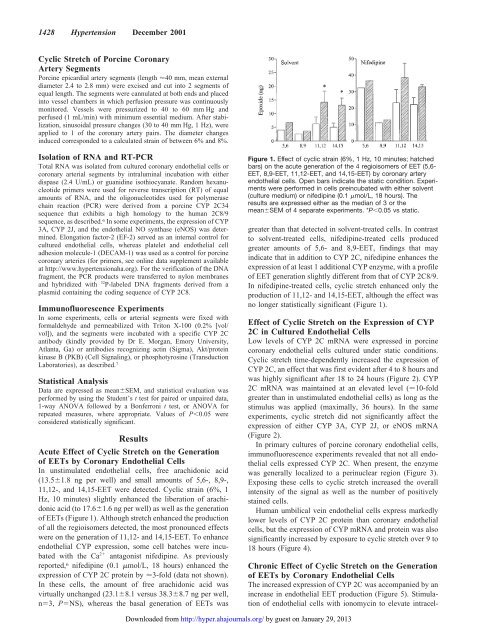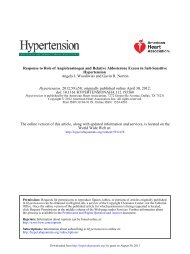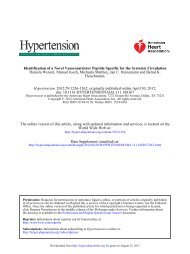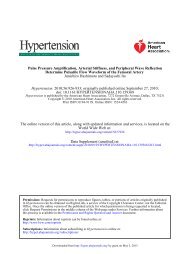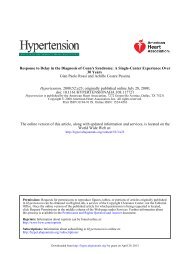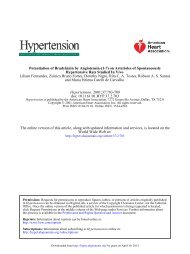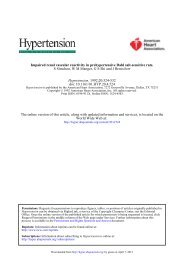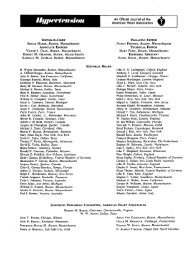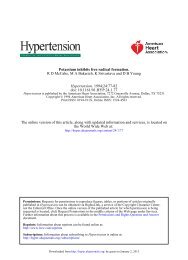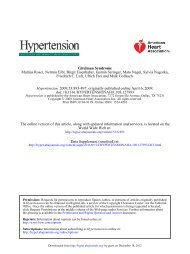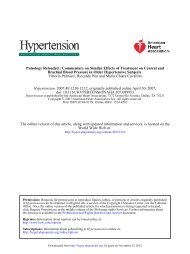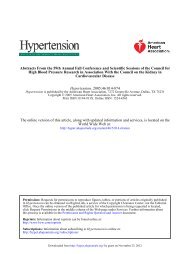Busse Beate Fisslthaler, Rüdiger Popp, U. Ruth ... - Hypertension
Busse Beate Fisslthaler, Rüdiger Popp, U. Ruth ... - Hypertension
Busse Beate Fisslthaler, Rüdiger Popp, U. Ruth ... - Hypertension
Create successful ePaper yourself
Turn your PDF publications into a flip-book with our unique Google optimized e-Paper software.
1428 <strong>Hypertension</strong> December 2001<br />
Cyclic Stretch of Porcine Coronary<br />
Artery Segments<br />
Porcine epicardial artery segments (length �40 mm, mean external<br />
diameter 2.4 to 2.8 mm) were excised and cut into 2 segments of<br />
equal length. The segments were cannulated at both ends and placed<br />
into vessel chambers in which perfusion pressure was continuously<br />
monitored. Vessels were pressurized to 40 to 60 mm Hg and<br />
perfused (1 mL/min) with minimum essential medium. After stabilization,<br />
sinusoidal pressure changes (30 to 40 mm Hg, 1 Hz), were<br />
applied to 1 of the coronary artery pairs. The diameter changes<br />
induced corresponded to a calculated strain of between 6% and 8%.<br />
Isolation of RNA and RT-PCR<br />
Total RNA was isolated from cultured coronary endothelial cells or<br />
coronary arterial segments by intraluminal incubation with either<br />
dispase (2.4 U/mL) or guanidine isothiocyanate. Random hexanucleotide<br />
primers were used for reverse transcription (RT) of equal<br />
amounts of RNA, and the oligonucleotides used for polymerase<br />
chain reaction (PCR) were derived from a porcine CYP 2C34<br />
sequence that exhibits a high homology to the human 2C8/9<br />
sequence, as described. 6 In some experiments, the expression of CYP<br />
3A, CYP 2J, and the endothelial NO synthase (eNOS) was determined.<br />
Elongation factor-2 (EF-2) served as an internal control for<br />
cultured endothelial cells, whereas platelet and endothelial cell<br />
adhesion molecule-1 (DECAM-1) was used as a control for porcine<br />
coronary arteries (for primers, see online data supplement available<br />
at http://www.hypertensionaha.org). For the verification of the DNA<br />
fragment, the PCR products were transferred to nylon membranes<br />
and hybridized with 32 P-labeled DNA fragments derived from a<br />
plasmid containing the coding sequence of CYP 2C8.<br />
Immunofluorescence Experiments<br />
In some experiments, cells or arterial segments were fixed with<br />
formaldehyde and permeabilized with Triton X-100 (0.2% [vol/<br />
vol]), and the segments were incubated with a specific CYP 2C<br />
antibody (kindly provided by Dr E. Morgan, Emory University,<br />
Atlanta, Ga) or antibodies recognizing actin (Sigma), Akt/protein<br />
kinase B (PKB) (Cell Signaling), or phosphotyrosine (Transduction<br />
Laboratories), as described. 7<br />
Statistical Analysis<br />
Data are expressed as mean�SEM, and statistical evaluation was<br />
performed by using the Student’s t test for paired or unpaired data,<br />
1-way ANOVA followed by a Bonferroni t test, or ANOVA for<br />
repeated measures, where appropriate. Values of P�0.05 were<br />
considered statistically significant.<br />
Results<br />
Acute Effect of Cyclic Stretch on the Generation<br />
of EETs by Coronary Endothelial Cells<br />
In unstimulated endothelial cells, free arachidonic acid<br />
(13.5�1.8 ng per well) and small amounts of 5,6-, 8,9-,<br />
11,12-, and 14,15-EET were detected. Cyclic strain (6%, 1<br />
Hz, 10 minutes) slightly enhanced the liberation of arachidonic<br />
acid (to 17.6�1.6 ng per well) as well as the generation<br />
of EETs (Figure 1). Although stretch enhanced the production<br />
of all the regioisomers detected, the most pronounced effects<br />
were on the generation of 11,12- and 14,15-EET. To enhance<br />
endothelial CYP expression, some cell batches were incubated<br />
with the Ca2� antagonist nifedipine. As previously<br />
reported, 6 nifedipine (0.1 �mol/L, 18 hours) enhanced the<br />
expression of CYP 2C protein by �3-fold (data not shown).<br />
In these cells, the amount of free arachidonic acid was<br />
virtually unchanged (23.1�8.1 versus 38.3�8.7 ng per well,<br />
n�3, P�NS), whereas the basal generation of EETs was<br />
Figure 1. Effect of cyclic strain (6%, 1 Hz, 10 minutes; hatched<br />
bars) on the acute generation of the 4 regioisomers of EET (5,6-<br />
EET, 8,9-EET, 11,12-EET, and 14,15-EET) by coronary artery<br />
endothelial cells. Open bars indicate the static condition. Experiments<br />
were performed in cells preincubated with either solvent<br />
(culture medium) or nifedipine (0.1 �mol/L, 18 hours). The<br />
results are expressed either as the median of 3 or the<br />
mean�SEM of 4 separate experiments. *P�0.05 vs static.<br />
greater than that detected in solvent-treated cells. In contrast<br />
to solvent-treated cells, nifedipine-treated cells produced<br />
greater amounts of 5,6- and 8,9-EET, findings that may<br />
indicate that in addition to CYP 2C, nifedipine enhances the<br />
expression of at least 1 additional CYP enzyme, with a profile<br />
of EET generation slightly different from that of CYP 2C8/9.<br />
In nifedipine-treated cells, cyclic stretch enhanced only the<br />
production of 11,12- and 14,15-EET, although the effect was<br />
no longer statistically significant (Figure 1).<br />
Effect of Cyclic Stretch on the Expression of CYP<br />
2C in Cultured Endothelial Cells<br />
Low levels of CYP 2C mRNA were expressed in porcine<br />
coronary endothelial cells cultured under static conditions.<br />
Cyclic stretch time-dependently increased the expression of<br />
CYP 2C, an effect that was first evident after 4 to 8 hours and<br />
was highly significant after 18 to 24 hours (Figure 2). CYP<br />
2C mRNA was maintained at an elevated level (�10-fold<br />
greater than in unstimulated endothelial cells) as long as the<br />
stimulus was applied (maximally, 36 hours). In the same<br />
experiments, cyclic stretch did not significantly affect the<br />
expression of either CYP 3A, CYP 2J, or eNOS mRNA<br />
(Figure 2).<br />
In primary cultures of porcine coronary endothelial cells,<br />
immunofluorescence experiments revealed that not all endothelial<br />
cells expressed CYP 2C. When present, the enzyme<br />
was generally localized to a perinuclear region (Figure 3).<br />
Exposing these cells to cyclic stretch increased the overall<br />
intensity of the signal as well as the number of positively<br />
stained cells.<br />
Human umbilical vein endothelial cells express markedly<br />
lower levels of CYP 2C protein than coronary endothelial<br />
cells, but the expression of CYP mRNA and protein was also<br />
significantly increased by exposure to cyclic stretch over 9 to<br />
18 hours (Figure 4).<br />
Chronic Effect of Cyclic Stretch on the Generation<br />
of EETs by Coronary Endothelial Cells<br />
The increased expression of CYP 2C was accompanied by an<br />
increase in endothelial EET production (Figure 5). Stimulation<br />
of endothelial cells with ionomycin to elevate intracel-<br />
Downloaded from<br />
http://hyper.ahajournals.org/ by guest on January 29, 2013


